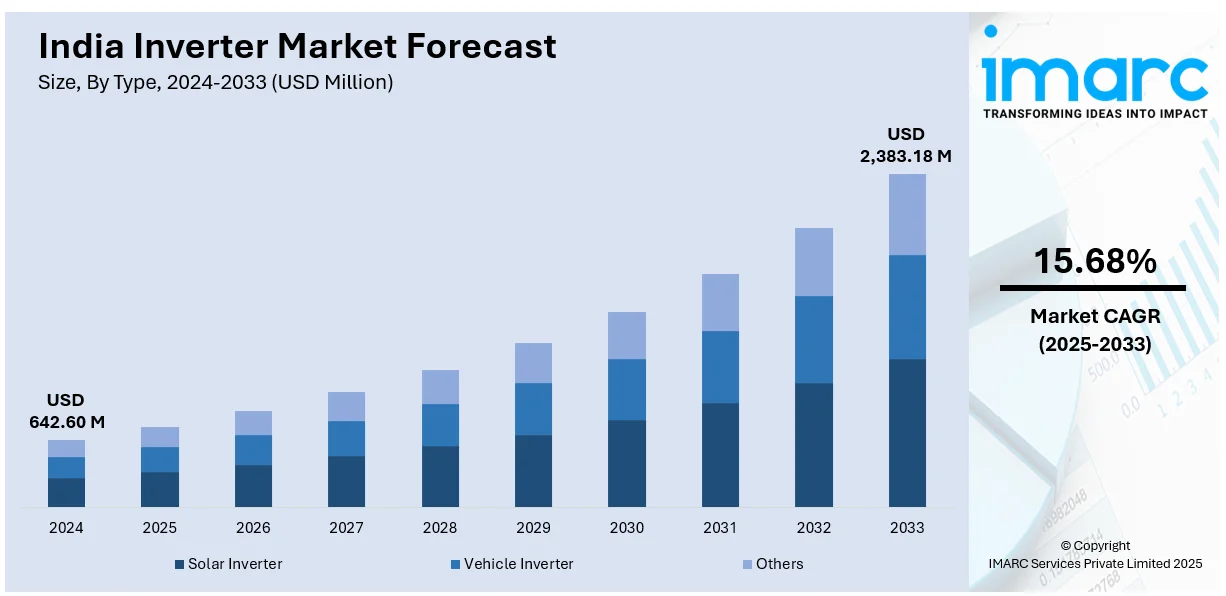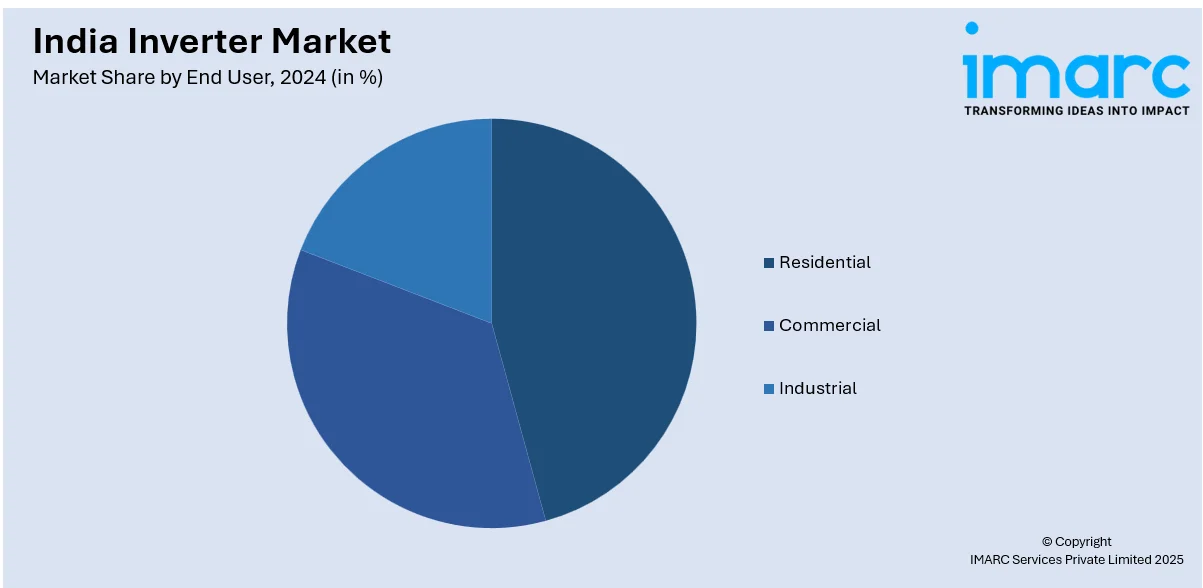
India Inverter Market Size, Share, Trends, and Forecast by Type, Output Power Rating, Connection Type, End User, and Region, 2025-2033
India Inverter Market Overview:
The India inverter market size reached USD 642.60 Million in 2024. Looking forward, IMARC Group expects the market to reach USD 2,383.18 Million by 2033, exhibiting a growth rate (CAGR) of 15.68% during 2025-2033. The market is experiencing significant growth driven by frequent power outages, rising electricity demand, rapid urbanization, and industrial expansion. Moreover, government support for renewable energy, technological advancements, increasing rural electrification, energy efficiency awareness and higher disposable incomes also contribute to India inverter market growth.
|
Report Attribute
|
Key Statistics
|
|---|---|
|
Base Year
|
2024 |
|
Forecast Years
|
2025-2033
|
|
Historical Years
|
2019-2024
|
| Market Size in 2024 | USD 642.60 Million |
| Market Forecast in 2033 | USD 2,383.18 Million |
| Market Growth Rate 2025-2033 | 15.68% |
India Inverter Market Trends:
Government Policies and Renewable Energy Initiatives
The Indian government is actively promoting renewable energy solutions, including solar inverters, through various initiatives such as subsidies, tax benefits, and incentives under programs like the Solar Rooftop Scheme. Policies like the Faster Adoption and Manufacturing of Electric Vehicles (FAME) scheme indirectly support inverter adoption by encouraging energy storage solutions. To ensure quality and performance, regulatory bodies are also setting clear product standards. For instance, in June 2024, the Ministry of New and Renewable Energy set guidelines for solar modules and inverters under the PM-Surya Ghar scheme. Modules must have a minimum 3-star rating, 500 W capacity, and a ten-year warranty, while inverters require specific efficiency standards and eight-year warranties. However, enrollment is optional for subsidy eligibility. These measures aim to reduce dependence on conventional energy sources, enhancing demand for efficient inverters. Moreover, advancements in solar power generation and net metering policies are encouraging residential and commercial users to integrate solar inverters contributing to higher deployment across urban and semi-urban areas and strengthening India inverter market share.

Technological Advancements and Energy Efficiency Trends
The inverter market in India is witnessing rapid technological advancements, including smart inverters, lithium-ion battery integration, and IoT-enabled energy management systems. Consumers are increasingly shifting toward energy-efficient inverters that reduce electricity consumption and operating costs. Advanced inverters with features like remote monitoring, higher power conversion efficiency, and longer battery life are gaining popularity. With rising awareness of sustainability and energy conservation, businesses and households prefer high-efficiency inverters, which comply with stringent energy standards. These innovations not only improve reliability but also align with India’s long-term sustainability goals, creating a positive India inverter market outlook. For instance, in January 2025, Solis announced the launch of its first hybrid inverter series in India, named the Solarator Series, targeting residential and commercial markets. This innovative lineup includes four models designed for various energy needs, featuring advanced storage and management capabilities. With the growing demand for renewable energy solutions in India, the Solarator series aims to drive efficiency and grid independence in the hybrid inverter market.
India Inverter Market Segmentation:
IMARC Group provides an analysis of the key trends in each segment of the market, along with forecasts at the regional level for 2025-2033. Our report has categorized the market based on type, output power rating, connection type, and end user.
Type Insights:
- Solar Inverter
- String Inverters
- Central Inverters
- Microinverters
- Others
- Vehicle Inverter
- Others
The report has provided a detailed breakup and analysis of the market based on the type. This includes solar inverter (string inverters, central inverters, microinverters, and others), vehicle inverter, and others.
Output Power Rating Insights:
- 0.5-1 MW
- 1-2 MW
- 2-5 MW
- 5-10 MW
- 10-20 MW
A detailed breakup and analysis of the market based on the output power rating have also been provided in the report. This includes 0.5-1 MW, 1-2 MW, 2-5 MW, 5-10 MW, and 10-20 MW.
Connection Type Insights:
- Grid-Tied
- Off-Grid
- Others
A detailed breakup and analysis of the market based on the connection type have also been provided in the report. This includes grid-tied, off-grid, and others.
End User Insights:

- Residential
- Commercial
- Industrial
A detailed breakup and analysis of the market based on the end user have also been provided in the report. This includes residential, commercial, and industrial.
Regional Insights:
- North India
- South India
- East India
- West India
The report has also provided a comprehensive analysis of all the major regional markets, which include North India, South India, East India, and West India.
Competitive Landscape:
The market research report has also provided a comprehensive analysis of the competitive landscape. Competitive analysis such as market structure, key player positioning, top winning strategies, competitive dashboard, and company evaluation quadrant has been covered in the report. Also, detailed profiles of all major companies have been provided.
India Inverter Market News:
- In October 2024, Solplanet, an inverter manufacturer from China, launched its three-phase 350 kW solar inverter (model ASW350K-HT) aimed at large PV installations in India. The maximum input current for the inverter is 75 amps, guaranteeing it works well with large PV modules. A conversion efficiency exceeding 99% guarantees that most of the energy generated by solar panels is effectively transformed into usable power, reducing energy loss.
- In October 2024, Livguard, part of the esteemed SAR Group, unveiled their latest series of high-frequency solar inverters at the current 17th Renewable Energy India Expo (REI) 2024. These latest products were introduced at the India Expo Center in Greater Noida, during a ceremony headed by Alankar Mittal, President Business Unit Leader for Solar and Exports.
India Inverter Market Report Coverage:
| Report Features | Details |
|---|---|
| Base Year of the Analysis | 2024 |
| Historical Period | 2019-2024 |
| Forecast Period | 2025-2033 |
| Units | Million USD |
| Scope of the Report |
Exploration of Historical Trends and Market Outlook, Industry Catalysts and Challenges, Segment-Wise Historical and Future Market Assessment:
|
| Types Covered |
|
| Output Power Ratings Covered | 0.5-1 MW, 1-2 MW, 2-5 MW, 5-10 MW, 10-20 MW |
| Connection Types Covered | Grid-Tied, Off-Grid, Others |
| End Users Covered | Residential, Commercial, Industrial |
| Regions Covered | North India, South India, East India, West India |
| Customization Scope | 10% Free Customization |
| Post-Sale Analyst Support | 10-12 Weeks |
| Delivery Format | PDF and Excel through Email (We can also provide the editable version of the report in PPT/Word format on special request) |
Key Questions Answered in This Report:
- How has the India inverter market performed so far and how will it perform in the coming years?
- What is the breakup of the India inverter market on the basis of type?
- What is the breakup of the India inverter market on the basis of output power rating?
- What is the breakup of the India inverter market on the basis of connection type?
- What is the breakup of the India inverter market on the basis of end user?
- What is the breakup of the India inverter market on the basis of region?
- What are the various stages in the value chain of the India inverter market?
- What are the key driving factors and challenges in the India inverter market?
- What is the structure of the India inverter market and who are the key players?
- What is the degree of competition in the India inverter market?
Key Benefits for Stakeholders:
- IMARC’s industry report offers a comprehensive quantitative analysis of various market segments, historical and current market trends, market forecasts, and dynamics of the India inverter market from 2019-2033.
- The research report provides the latest information on the market drivers, challenges, and opportunities in the India inverter market.
- Porter's five forces analysis assist stakeholders in assessing the impact of new entrants, competitive rivalry, supplier power, buyer power, and the threat of substitution. It helps stakeholders to analyze the level of competition within the India inverter industry and its attractiveness.
- Competitive landscape allows stakeholders to understand their competitive environment and provides an insight into the current positions of key players in the market.
Need more help?
- Speak to our experienced analysts for insights on the current market scenarios.
- Include additional segments and countries to customize the report as per your requirement.
- Gain an unparalleled competitive advantage in your domain by understanding how to utilize the report and positively impacting your operations and revenue.
- For further assistance, please connect with our analysts.
 Inquire Before Buying
Inquire Before Buying
 Speak to an Analyst
Speak to an Analyst
 Request Brochure
Request Brochure
 Request Customization
Request Customization




.webp)




.webp)












